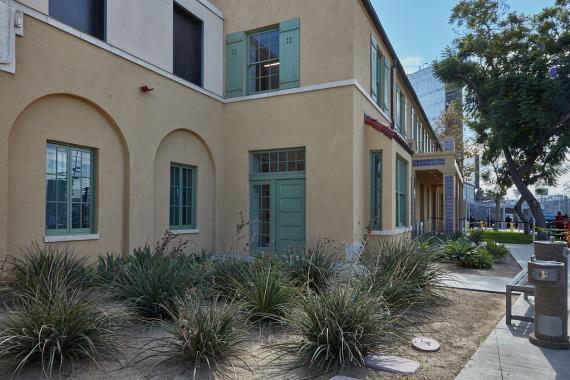Location: E San Ysidro Blvd, San Diego, CA 92173

The old Custom Building at the San Ysidro Border Station is listed in the National Register of Historic Places. Although listed in 1982 at the local level of significance, its role is a national one, and subsequent listing in the National Register of the Calexico station at the national level of significance supports a similar finding for San Ysidro. The most heavily trafficked of the California border stations between the United States and Mexico, the old San Ysidro Customs Building is important for its role in politics and government as a custom house, where U.S. policies for international political and economic relations have been directly implemented since 1933, as well as for its impact as an immigration station which directly affected the Hispanic heritage of the region. The station is also recognized as a notable example of regional Spanish Colonial Revival architecture as interpreted by the Depression-era federal building program under which is was constructed.
The border station is the most important activity in San Ysidro, a community about fifteen miles south of the incorporated city of San Diego. Increasing border traffic in both goods and people led Collector of customs, William H. Ellison, to comment, in regards to the border facilities at San Ysirdro, Tecate, and Calexico: “We need the buildings very much, as out present quarters at those places are crowded, and I am urging both the treasury and the customs and immigration bureaus that actual construction be speeded as much as possible.” At the time (the early 1930s), the border authorities in San Ysidro were operating from a single story frame building. San Diego boosters, foreseeing the possibilities for local prosperity, were enthusiastic backers of the proposal for a larger, more efficient operation at the border.
The federal agency responsible for the construction of the old Customs Building at San Ysidro in 1932 was the Public Buildings Branch of the Procumbent Division of the U.S. Treasury Department. Part of a massive federal construction program began in 1926 under the Hoover Administration and continued under Roosevelt’s Public Works Administration, the San Ysidro station was realized under the aegis of Acting Supervising Architect James A. Wetmore. Design credit probably belongs to the Superintendent of the Architectural Division of the Treasury, Louis A. Simon. In keeping with the general practice of the federal building program, the San Ysidro customs house is characterized by a restrained use of local architectural tradition, executed - in so far as was feasible - using local materials and craftsmen.
Acquisition of the property for the building was completed in 1931. Work began in the spring of 1932, with a ground-breaking ceremony attended by federal and county officials, local businessmen, and a contingent of government and officials for Tiajuana. Construction was completed in May of the following year.
Like its counterparts at Tecate (1933) and Calexico (1933), the border station at San Ysidro played a critical role in the daily life of the communities and the two nations it served. The old Customs Building at San Ysidro continued in its original function until 1974, when it was supplanted by a new border station nearby. Despite alterations, the exterior retains a high degree of architectural character and integrity.
Facts
- Architect: James A. Wetmore
- Construction Dates: 1932-1933
- GSA Building Number: CA0581GG
- Landmark Status: Listed in the National Register of Historic Places

 U.S. General Services Administration
U.S. General Services Administration
